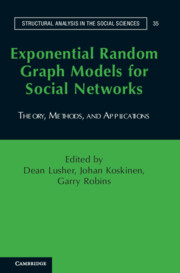Book contents
- Frontmatter
- Contents
- List of Figures
- List of Tables
- 1 Introduction
- Section I Rationale
- Section II Methods
- Section III Applications
- 14 Personal Attitudes, Perceived Attitudes, and Social Structures: A Social Selection Model
- 15 How To Close a Hole: Exploring Alternative Closure Mechanisms in Interorganizational Networks
- 16 Interdependencies between Working Relations: Multivariate ERGMs for Advice and Satisfaction
- 17 Brain, Brawn, or Optimism? Structure and Correlates of Emergent Military Leadership
- 18 Autologistic Actor Attribute Model Analysis of Unemployment: Dual Importance of Who You Know and Where You Live
- 19 Longitudinal Changes in Face-to-Face and Text Message–Mediated Friendship Networks
- Chapter 20 Differential Impact of Directors’ Social and Financial Capital on Corporate Interlock Formation
- 21 Comparing Networks: Structural Correspondence between Behavioral and Recall Networks
- Section IV Future
- References
- Index
- Name Index
Chapter 20 - Differential Impact of Directors’ Social and Financial Capital on Corporate Interlock Formation
Published online by Cambridge University Press: 05 April 2013
- Frontmatter
- Contents
- List of Figures
- List of Tables
- 1 Introduction
- Section I Rationale
- Section II Methods
- Section III Applications
- 14 Personal Attitudes, Perceived Attitudes, and Social Structures: A Social Selection Model
- 15 How To Close a Hole: Exploring Alternative Closure Mechanisms in Interorganizational Networks
- 16 Interdependencies between Working Relations: Multivariate ERGMs for Advice and Satisfaction
- 17 Brain, Brawn, or Optimism? Structure and Correlates of Emergent Military Leadership
- 18 Autologistic Actor Attribute Model Analysis of Unemployment: Dual Importance of Who You Know and Where You Live
- 19 Longitudinal Changes in Face-to-Face and Text Message–Mediated Friendship Networks
- Chapter 20 Differential Impact of Directors’ Social and Financial Capital on Corporate Interlock Formation
- 21 Comparing Networks: Structural Correspondence between Behavioral and Recall Networks
- Section IV Future
- References
- Index
- Name Index
Summary
Bipartite Society: The Individual and the Group
The interdependence of the individual and the organization is an enduring theme in sociological thought. Cooley wrote that “man may be regarded as the point of intersection of an indefinite number of circles representing social groups, having as many arcs passing through him as there are groups” (1902/1964, 148). Simmel (1955) captured the tension between the individual and the organization when he defined two types of group affiliation: “organic membership,” where the organization is not chosen by the individual as an expression of his or her traits (e.g., as in the case of the family), and “rational membership,” where the organization is chosen as a conscious expression of the individual's traits. For Simmel, the most important outcome of an individual's affiliation to an organization was the constraint and socialization of the individual; an individual, he laments, “is determined sociologically in the sense that groups ‘intersect’ in his person by virtue of his affiliations with them” (150).
Social network analysis has developed a distinctive and highly systematic set of methods for representation, measurement, and (more recently) modeling of this interdependence called, variously, “membership networks,” “affiliation networks,” “bipartite networks,” and “two-mode networks” (Breiger, 1974; Robins & Alexander, 2004; Wang, Sharpe, Robins, & Pattison, 2009). The advantage of bipartite networks is that they preserve the dualistic structure of organization–individual relations, representing the network as ties between a set of individuals and a set of organizations. They avoid simplifying the relationships into the one-mode form of either a network of individuals or a network of organizations (see Chapter 10, Section 10.2, for more on bipartite networks).
Information
- Type
- Chapter
- Information
- Exponential Random Graph Models for Social NetworksTheory, Methods, and Applications, pp. 260 - 271Publisher: Cambridge University PressPrint publication year: 2012
